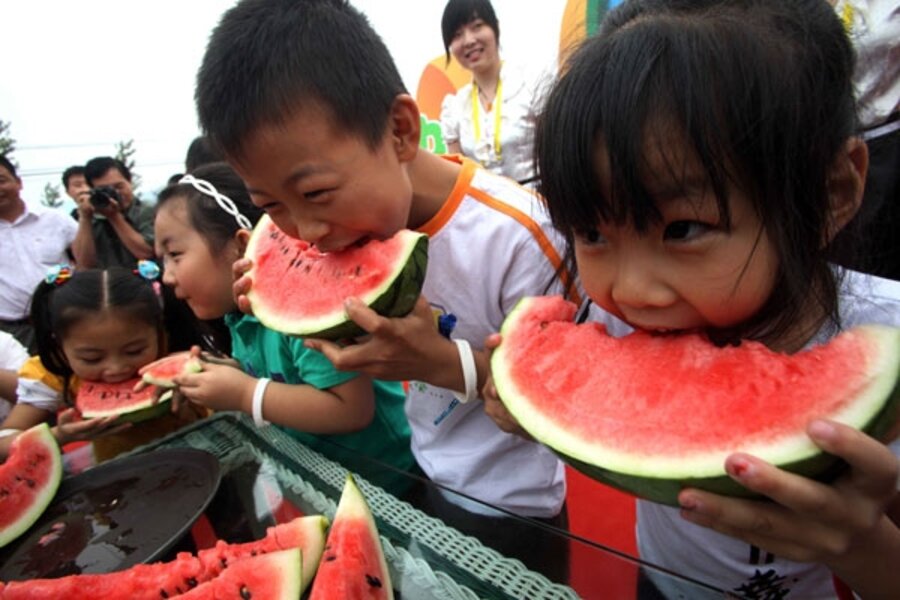Summertime is watermelon time
Loading...
I am sympathetic to Roger Doiron's crusade to eat locally on July 4, but have to admit that my desire for watermelon on Independence Day ruled that out for me.
I'm in Boston, where no watermelon will ripen in fields for quite some time yet. But I grew up where watermelon was a local crop harvested by the Fourth, and I simply can't imagine a summer picnic without it. For Independence Day, it's an inviolate tradition at my house.
But as rivulets of red juice ran down our chins at the end of our cookout Saturday, we discussed the appeal of the big red and green fruit. And several people had watermelon questions they'd always wondered out. These were directed at me, as the so-called expert on all things horticultural. (Or at least the person closest at hand who was most likely to know the answers.)
Question 1: Where did watermelon originate? Is it an American fruit? No, I said, it originally came from Africa (National Geographic confirms that) and Egypt (which is, of course, northern Africa), but has been grown around the world for thousands of years.
Question 2: Why do seedless watermelons almost always have a few seeds? And why are they then called seedless if they aren't? Part of the answer to that comes from understanding how seedless melons are developed. (How can you get seeds if the fruit is seedless?)
Here's a relatively simple explanation from the Texas Agricultural Extension Service:
The number of chromosomes (the threadlike bodies within cells that contain the inheritance units called genes) in a normal watermelon plant is doubled by the use of the chemical colchicine. Doubling a normal (diploid) watermelon results in a tetraploid plant (one having four sets of chromosomes). When the tetraploid plant is bred back, or pollinated, by a diploid or normal plant, the resulting seed produces a triploid plant that is basically a "mule" of the plant kingdom, and it produces seedless watermelons.
What you call "seeds," Jerry Parsons of the Texas Agricultural Extension Service refers to as "white seedlike structures that are edible."
Donald Maynard of the Florida Extension Service provides more detail:
Small, white rudimentary seeds or seedcoats, which are eaten along with the fruit as in cucumber[s], develop within the fruit. The number and size of these rudimentary seeds vary with variety. An occasional dark, hard, viable seed is found in triploid melons.
Question 3: Why isn't this melon cold? Well, the obvious answer is, there's only so much room in one refrigerator. But last summer, a neighbor told me something about watermelon I'd not known before. It's best to store an uncut watermelon at room temperature, because it will be more nutritious than a cold melon. (Of course, after cutting, the watermelon has to be refrigerated.) But that's interesting because it's the opposite of what you might think.
As it turned out, I had a question of my own. We'd bought little icebox melons on sale for $3.99 each, and I noticed they were "branded" with a cultivar name, Revolution. Seemed appropriate for the holiday. But what interested me was that they were oblong.
We're used to that in large watermelons, but I tend to think of the minis as round. But it turns out that Revolution isn't alone in being small and oblong. Looking around on the Web, I found a number, although the majority seem to be seeded, not seedless.
I prefer seedless melons and wondered if it was really true they tasted sweeter than seeded kinds. Yes, says the University of Illinois Extension Service.
The little watermelon I've always depended on (at least before I moved north and became an urban resident) is Sugar Baby. It's so easy to grow, even beginners will be successful, as long as they live where the season's long enough.
If you've got space and a favorable climate, watermelon is easy to grow and fun. It's too late this year, but add it to your plans for late next spring.
And when you're ready to harvest, here are nine ways to tell if it's ripe.
As you can tell, I'm a big fan of watermelon. It keeps me going until fresh peach season arrives in Massachusetts. Now, that's something to rave over, no questions about it.
Gardening in the news:
In His New Grass is Greener, The Boston Globe's business sections reports on a man who's developed a grass that needs mowing just once a month.
Also in Boston, the effects of a month of rain on a public rose garden: Drenched Floral Dreams.
The new White House kitchen garden has tested positive for lead, but not a dangerous amount. The New York Times noted that veggies such as tomatoes, squash, eggplants, and beans don't accumulate much lead.
If you enjoy gardening, you'll find much more on the main Monitor gardening page: at least one new blog post and one new gardening article each weekday.
You may also want to visit Gardening With the Monitor on Flickr. If you join the group (it's free), you can upload your garden photos (and possibly win a prize). Join the discussions and get answers to your gardening questions.
And finally, you can now follow us on Twitter.





